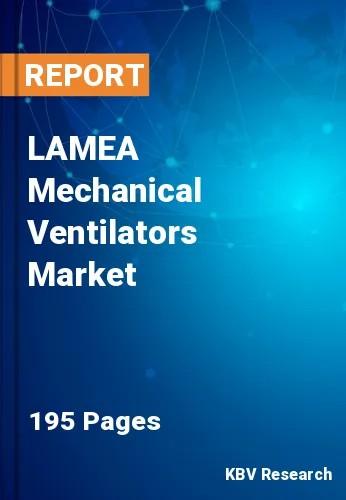The Latin America, Middle East and Africa Mechanical Ventilators Market would witness market growth of 15.3% CAGR during the forecast period (2023-2030). In the year 2026, the LAMEA market's volume is expected to surge to 139.6 thousand units, showcasing a growth of 16.4% (2023-2030).
A mechanical ventilator assists individuals who are critically ailing and unable to breathe unaided. Inserting a hollow tube into the patient's mouth and down into their trachea is an artificial airway, allowing the patient to be connected to the ventilator. Additionally, as a diagnostic tool, mechanical ventilators are utilized to evaluate respiratory system abnormalities and static compliance of airway resistance. In medical emergencies and surgical procedures, mechanical ventilators are a life-saving technology. Patients with breathing problems, spinal cord injuries, strokes, and other conditions are the main users of these devices.
The regional population is ageing, and the elderly are more vulnerable to respiratory diseases and critical illnesses. As a result, mechanical ventilators are becoming increasingly important in treating this demographic. The prevalence of respiratory diseases, including chronic obstructive pulmonary disease (COPD), asthma, and pneumonia, has been witnessing an upward trend. Mechanical ventilators are essential for the management and treatment of these disorders, particularly in severe cases. The expanded applicability and increased adoption of these devices can be attributed to their advanced features, which include adaptive pressure control, dual-limb circuits, and enhanced monitoring capabilities.
According to the Saudi Health Council, lung cancer is the sixth most common disease in Saudi males and the twelfth most common cancer in Saudi females. In 2018, Saudi Arabia had 504 new lung cancer cases or 3.2% of all newly diagnosed cases. The prevalence of smoking, both among men and women, is relatively high in Saudi Arabia. Mechanical ventilators have evolved to adapt to the unique healthcare needs in South Africa, including managing respiratory conditions prevalent in the region. The increased availability of advanced mechanical ventilators helps reduce healthcare disparities in South Africa, ensuring patients in urban and rural areas access state-of-the-art critical care. The factors mentioned above will drive the regional market growth.
The Brazil market dominated the LAMEA Mechanical Ventilator Market by Country in 2022 and would continue to be a dominant market till 2030; thereby, achieving a market value of $308.3 million by 2030. The Argentina market is showcasing a CAGR of 16% during (2023 - 2030). Additionally, The UAE market would register a CAGR of 15% during (2023 - 2030).
Based on Mode, the market is segmented into Invasive Ventilation, and Non-invasive Ventilation. Based on Component, the market is segmented into Devices, and Services. Based on Product Type, the market is segmented into Intensive Care Unit/Critical Care, Transport/Portable/Ambulatory, and Neonatal Care. Based on Age Group, the market is segmented into Adult, Geriatric, and Pediatric & Neonatal. Based on End User, the market is segmented into Hospital & Clinic, Ambulatory Surgical Center, Home Care, and Others. Based on countries, the market is segmented into Brazil, Argentina, UAE, Saudi Arabia, South Africa, Nigeria, and Rest of LAMEA.
Free Valuable Insights: The Worldwide Mechanical Ventilators Market is Projected to reach USD 16.7 Billion by 2030, at a CAGR of 12.6%
The market research report covers the analysis of key stake holders of the market. Key companies profiled in the report include GE HealthCare Technologies, Inc., Koninklijke Philips N.V., Medtronic PLC, Dragerwerk AG & Co. KGaA, Getinge AB, Asahi Kasei Corporation (Zoll Medical Corporation), Hamilton Medical AG (Hamilton Bonaduz AG), Carl Reiner GmbH, Mindray Medical International Limited and Vyaire Medical, Inc.
By Mode (Volume, Thousand Unit, USD Billion, 2019-30)
By Component (Volume, Thousand Unit, USD Billion, 2019-30)
By Product Type (Volume, Thousand Unit, USD Billion, 2019-30)
By Age Group (Volume, Thousand Unit, USD Billion, 2019-30)
By End User (Volume, Thousand Unit, USD Billion, 2019-30)
By Country (Volume, Thousand Unit, USD Billion, 2019-30)
Our team of dedicated experts can provide you with attractive expansion opportunities for your business.

